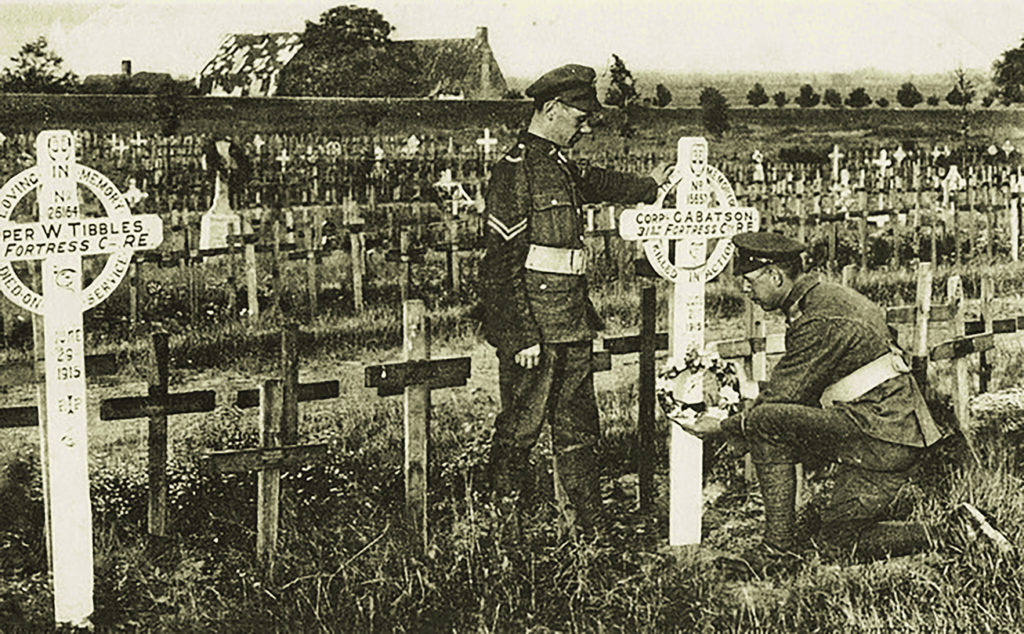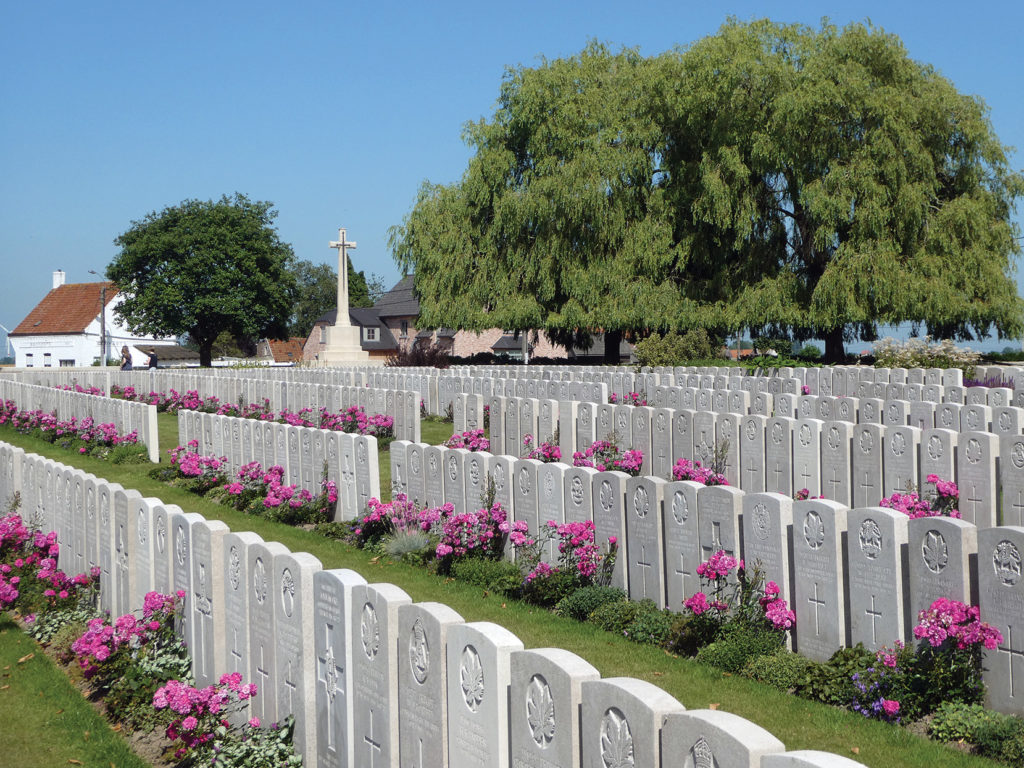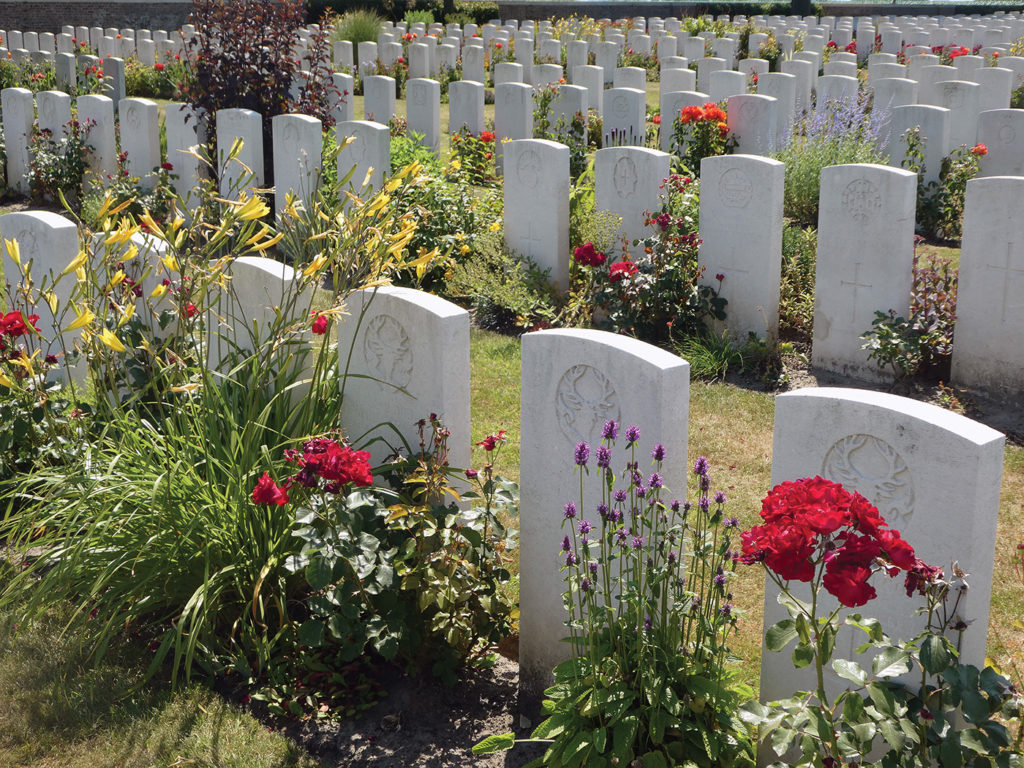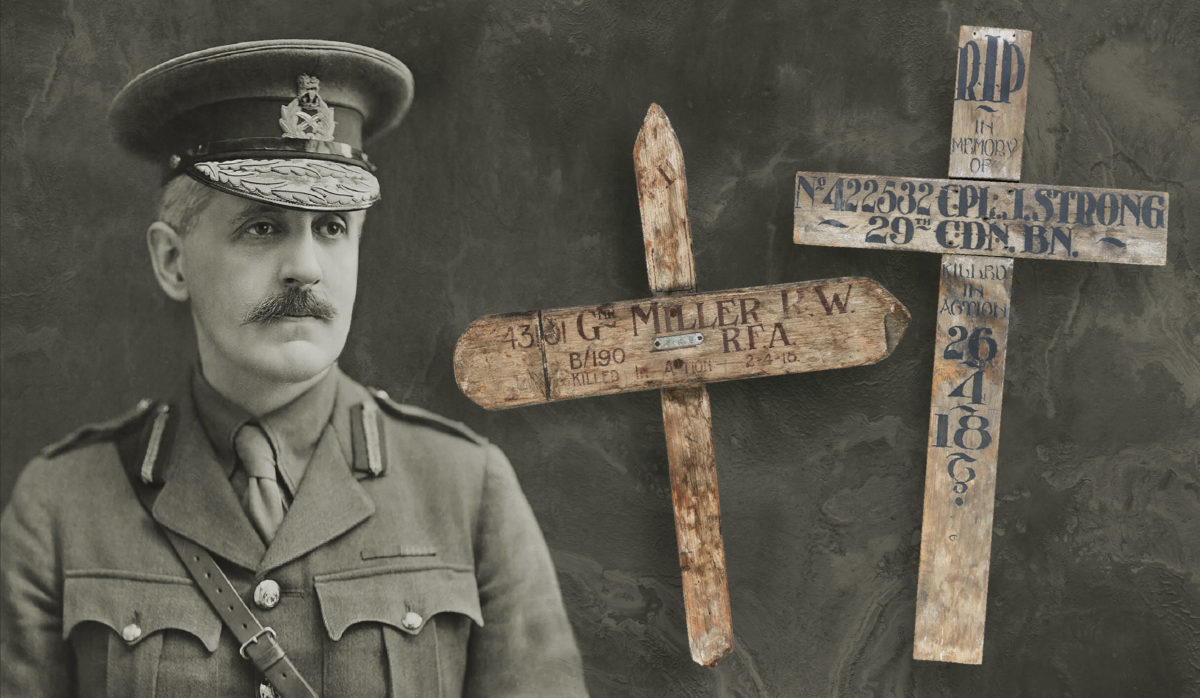On August 3, 1914, Sir Edward Grey, British Foreign Secretary, said to a friend, “The lamps are going out all over Europe; we shall not see them lit again in our lifetime.” The so-called Great War lasted more than four years at the cost of an estimated 9.7 million soldiers.
The sacrifice of so many called for remembrance of the fallen in each warring nation. In Britain, one man anticipated this need—even during the war’s earliest stages.
An Unlikely Advocate
Little known and underappreciated, Fabian Ware was born on June 17, 1869 in Bristol, England. His father, a chartered accountant, was a member of the Plymouth Brethren, a nonconformist Christian movement. Fabian was educated with strict emphasis on the ideals of duty and piety. At age 18 he became a teacher to fund his university studies after his father’s death.
Ware became an inspector to schools and wrote books on educational reform. In 1901 he travelled to South Africa to help with reconstruction following the Second Boer War (1899-1902). Establishing himself as a skilled administrator, he became Director of Education in the Transvaal.
While in South Africa, he developed a love for public service. Back in England in 1905, he became editor of the Morning Post, covering news of colonial affairs and supporting social reform. Matters of social reform became controversial and in 1911 Ware left his post, becoming consultant to the Rio Tinto mining company where he put his linguistic skills to good use while negotiating with the French government.
Changed by the War
Following the Great War’s outbreak in August 1914, Ware was keen to “do his bit” for his country. Too old to join the Army, he volunteered to go to France to provide humanitarian aid for war casualties. He was put in charge of a Red Cross mobile ambulance unit conveying wounded soldiers to hospitals along the French front.
In October 1914, Ware visited British war graves in the communal cemetery of Béthune in northern France. There he realized the pressing need to find proper resting places for dead soldiers and to accurately record burials. The Red Cross in Britain was then overwhelmed with requests from relatives about the resting places of loved ones.
The Army reluctantly accepted Ware’s suggestions for better care of graves. In March 1915, the Graves Registration Commission was put in place and by October was controlled by the Army as the Graves Registration Unit. Ware was made Temporary Major. General Douglas Haig recognized the merit of the unit’s work, writing to the War Office: “It has an extraordinary moral value to the Troops in the Field as well as to the relatives and friends of the dead at home.”

As casualties mounted, Ware’s focus turned to care and maintenance of graves following the end of the conflict. In January 1916, the National Committee for the Care of Soldiers’ Graves was created. The Prince of Wales, the future King Edward VIII, was president.
A Huge Quest Begins
Demands made on the Graves Registration Unit were so great that by spring 1916 it had evolved into a bigger organization: the Directorate of Graves Registration and Enquiries. Promoted to the rank of Temporary Lieutenant Colonel, Ware became its director and managed 700 staff. By now 500,000 graves were registered and 12,000 photographs of graves marked by wooden crosses had been sent to families.
An important task was securing land from the French and Belgian governments to provide for the additional cemeteries. With his linguistic and negotiating skills, Ware was instrumental in acquiring plots at no cost from these nations. He succeeded in obtaining agreements giving Britain control of caring for these cemeteries.
In early 1917, Ware, supported by the Prince of Wales, presented a memorandum at the Imperial War Conference. He suggested setting up an organization involving all countries of the British Empire. This became known as the Imperial War Graves Commission and was established by Royal Charter on May 21, 1917. Ware served as vice chairman, the Secretary of State for War (Lord Derby) was chairman and the Prince of Wales was president.
Frederick Kenyon, the Director of the British Museum, became the commission’s architectural adviser. He travelled to Belgium and France to see the work that needed to be done and recommended that a team of architects be appointed. Edwin Lutyens, Herbert Baker and Reginald Blomfield were chosen. After traveling to the battlefields, Lutyens wrote to his wife that “the dotted graves are pathetic…what humanity can endure, suffer, is beyond belief.”
Equality in Sacrifice
Kenyon used all his conciliatory skills to bring together different views for the cemeteries into one vision. The overall concept agreed upon was to emphasize equality. No difference would be made between race, rank or religion.
These were most progressive ideas in those times. Kenyon hoped that “the cumulative effect of the cemeteries and memorials would express the common spirit of the nation, the common purpose of the army and the common sacrifice of the individual.”
Famed writer Rudyard Kipling who lost his only son John in 1915 was an early supporter. In February 1919, he wrote an article in The Times detailing the commission’s plans.
The non-repatriation of bodies proved the cause of nationwide controversy. In March 1915, French commander General Joseph Joffre banned exhumations of British soldiers in France. Field Marshal Sir John French, then commander-in-chief of the British Expeditionary Force, approved. However the body of William Gladstone, a lieutenant in the Royal Welsh Fusiliers, was repatriated home the following month. He happened to be the grandson of former Prime Minister W. E. Gladstone. This created a stir.
Ware remarked that “the impression it has created among the soldiers out here is to be regretted.” Allowing the repatriation of bodies went against the idea of brotherhood. It would be appropriate for the majority of officers, if killed, to be buried with their men.
Moreover a large-scale operation to exhume and transport bodies back to Britain was a potential logistical nightmare and health hazard. Families seeking repatriation would face financial challenges. However it is estimated that at least 27 war dead were repatriated.
A War Over Crosses?
Another controversy facing the commission focused on grave markers to replace temporary wooden crosses. The traditional Latin cross was rejected since there were non-Christians among the dead. A headstone was suggested. It would allow space for details known about the soldier, a religious symbol and a regimental badge engraving.
Yet many people resisted the commission’s approach. Yorkshire housewife Sarah Smith lost her 19-year old son on the Somme in 1918. Distressed that her son’s body would not be returned, she organized a petition in May 1919 and managed to collect more than 2,500 signatures.
This petition was sent to the Prince of Wales with an attached letter.
Smith argued, “It has always been the view of every English family that their beloved dead belonged to them alone.”
Her petition was unsuccessful.
However, she set up a rival organization called the British War Graves Association to pressure authorities and gained the support among the aristocracy. The group’s vice-president, Lady Florence Cecil, lost three of four sons and organised a petition with 8,000 signatures for a cross to be used as a grave marker.
Winston Churchill StePs IN
Leading suffragist Beatrix Maud Palmer, Countess of Selborne, was also involved. She was the sister-in-law of Lady Cecil and the oldest child of former Prime Minister Robert Gascoyne-Cecil, and thus had influential connections.
She described burials in foreign cemeteries as “the most heartless and unnecessary woodenness” and angrily criticized Ware’s work as “these state cemeteries.”

The fierce debate was aired in the House of Commons. Supported by Rudyard Kipling, William Burdett Coutts, the Member of Parliament for the City of Westminster presented the case for the Imperial War Graves Commission on May 4, 1920, arguing that their vision represented “the union of all, in motive, in action and in death.”
Lord Robert Cecil, brother of Lady Selborne and one of the founders of The League of Nations, spoke against the non-repatriation of bodies and uniform headstones.
Winston Churchill, Secretary of State for War and therefore chairman of the Imperial War Graves Commission, ended the debate with an inspiring speech. Churchill argued for fellowship in death and the democratic ideals behind the commission’s principles.
“Nearly all who have been to see these cemeteries have been profoundly impressed by their sense of beauty, of repose and of comfort,” said Churchill. Unsurprisingly, Churchill won the day with his powerful words.
Creating English Gardens
The aesthetic appearance of the war cemeteries was carefully designed. During 1916, Captain Arthur Hill, the Assistant Director of the Royal Botanic Gardens at Kew, visited the Western Front to develop horticultural plans and remarked, “There is nothing more British than grass lawns.” Inspiration was drawn from Impressionist paintings emphasizing texture and color to create “almost English gardens” with hardy flowerbeds.
The commission planted roses and herbaceous perennials in front of the graves to create perpetual bouquets. The commission chose Floribunda roses, which produce bright fragrant blooms, are extremely hardy and bloom throughout summer until first frost. The commission named the type of rose used in the cemeteries as the “Remembrance” rose. Most headstones are made of Portland stone, a soft white stone with a clean and bright appearance. This garden-like atmosphere was intended to help visiting relatives come to terms with their grief.
Demobbed soldiers became the commission’s first gardeners. Organized into teams with the amusing name of “traveling garden parties,” they moved from site to site in trucks with tents and food supplies.
Gathering the Dead
After war’s end, former battlefields had to be cleared of all debris and trenches needed to be filled in. Royal Engineers and men of the Chinese Labour Corps performed this task. Many died or were maimed when live munitions exploded.
The most grim and thankless task was retrieving tens of thousands of unburied bodies. The commission tried to identify them whenever possible. In general, an old frontline was searched six times. Where fighting had been intense, areas were searched up to twenty times.
By the Armistice, about 600,000 burials had been recorded. From 1918 to 1921 more than 200,000 bodies were recovered, many greatly decayed. When farmers returned to till their fields, corpses were ploughed up. By 1937, bodies were still being discovered at a rate of 20 to 30 per week. Even to this day bodies from the war continue to be unearthed.

Sir Reginald Blomfield designed three cemeteries in France. Every cemetery, except for very small ones, includes the Blomfield-designed monument called the Cross of Sacrifice—a white stone cross incorporating a bronze crusader sword.
For cemeteries containing more than 400 burials, Lutyens created the Stone of Remembrance monument, bearing words chosen by Kipling from the Book of Ecclesiastes: “Their name liveth for evermore.” It also commemorates “those of all faiths and none.”
“Silent Witnesses”
Each headstone is 2 feet 8 inches tall, 1 foot 3 inches wide and 3 inches thick. Its top is curved for the practical reason of letting rainwater run off, yet also creates an aesthetically pleasing shape. Known information about the casualty is engraved: name, rank, army number, regiment and date of death. A religious symbol, if appropriate, is also shown. The majority of graves display a cross.
Families were able to choose a unique personal epitaph of a maximum of 66 words which were approved by the commission. Some display classical or poetic references, for example, “dulce et decorum est pro patria mori,” (“it is sweet and fitting to die for one’s country.”). Others are inscribed with personal tributes, such as: “One of the best God could send, splendid memory left behind, mother.” Others include anti-war messages, such as: “Sacrificed to the fallacy that war can end war.” Unidentified casualties were given a headstone with words chosen by Kipling: “A Soldier of the Great War known unto God.”
Accompanied by Ware, King George V toured cemeteries in France and Belgium in 1922. After returning home, he stated: “In the course of my pilgrimage, I have many times asked myself whether there can be more potent advocates of peace upon earth through the years to come than this massed multitude of silent witnesses to the desolation of war.” He hoped that “the existence of these visible memorials will eventually serve to draw all peoples together in sanity and self-control.”
A Monumental Achievement
The commission’s achievements cannot be overestimated. Kipling claimed the construction of the cemeteries and memorials was “the biggest single bit of work since the Pharaohs and they only worked in their own country.”
In 1918 Ware gained promotion to Major General and, in 1922, was knighted for his remarkable work. In 1936—the year a belligerent Adolf Hitler marched German troops back into the Rhineland—Ware attended a conference at Cologne, Germany about the German War Graves Commission (Volksbund Deutsche Kriegsgräberfürsorge). Ware delivered a speech suggesting that war cemeteries could promote “a blessed healing of wounds” but included a timely warning to his audience about the risk of another war.
By the early 1920s, 4,000 headstones were being sent to France per week. More than 500 cemeteries had been built by 1927. The largest British cemetery in the world is Tyne Cot Cemetery near Passchendaele in Belgium, which contains nearly 12,000 graves. By 1937, 1,850 British war cemeteries had been built by the commission.
Ware’s Twilight Years
That same year, Ware published a book entitled The Immortal Heritage, in which he detailed the commission’s work from 1917 to 1937. War poet Edmund Blunden wrote in his introduction of “the degree of beauty achieved by the creators and guardians of these resting places.”
At age 70, Ware accepted the post of Director General of the Graves Registration and Enquiries at the War Office when British troops began fighting again in Europe in 1940. Backed by Churchill, he recorded the deaths of civilians during World War II and continued his work as the commission’s vice chairman until his health failed in 1948.
He died on April 28, 1949 at age 79 and was buried in the churchyard of Holy Trinity in Gloucestershire. A memorial stone to him is enshrined in the hallowed halls of Westminster Abbey in London. His wife, Anna, asked to comment on her husband, simply answered: “His life was his work.”
Today the commission, renamed the Commonwealth War Graves Commission in 1960, commemorates 1.7 million war dead in 153 countries—an unequaled enterprise in world history.





